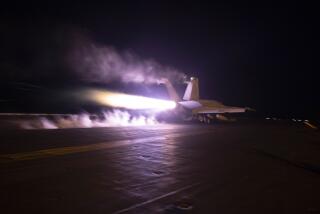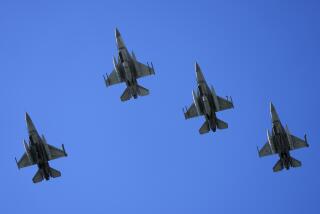THE GULF WAR : FIGHTING AIR TO GROUND
- Share via
Allied coalition forces have flown thousands of missions over Iraq and Kuwait since hostilities began Jan. 17. Here, in simplified form, is a breakdown of the basic kinds of armaments used in the air, the kinds of targets they are designed to destroy and their limitations and vulnerabilities.
Guns: --Used against soft targets like vehicles and trucks. --AH-64 Apache helicopter carries a 25-millimeter rapid-fire gun, primarily effective against vehicles and armored personnel carriers that do not have thick armor. --AV-8B Marine Harrier carries 20-millimeter cannon for use against soft targets. --A-10 Thunderbolt, a dedicated tank-killer, fires 30-millimeter cannon in its nose. Its extremely powerful shells are about the size of milk bottles. LIMITATIONS: --Attacker is drawn into range of air defense systems, especially the A-10, which flies low and slowly. ALTITUDE: --Has to fly in as low as 500 feet in order to see and hit target. --The helicopter can come in even lower and can use ground terrain to conceal itself. Rockets: --Primarily effective against massed soft targets: vehicles, troops, cluster or frame buildings, radar installations. --Most commonly used are high explosive 70-millimeter rockets, fired in salvos of 20-30. --Carried by A-10 or AH-64 aircraft. LIMITATIONS: --Subject to enemy ground fire and not effective on hard targets ALTITUDE: --Can come in as low as 2,000 feet; helicopter would come in even lower. Smart Bombs: --Used agains “point” targets, such as individual buildings requiring precision bombing. --Most commonly used are 500, 1,000- or 2,000-lb. bombs that are electronically guided directly to the target. --Aircraft are medium-range fighter-bombers: the F-115E Eagle, A-6 Intruder, and F-111A Aardvark. LIMITATIONS: --Subject to enemy ground fire, anti-aircraft missile or cannon. ALTITUDE: --Depending on target and cloud cover, they can range from 2,000-5,000 feet. Free-Fall Bombs: --Used against any large concentration of troops, equipment, vehicles, airfield installations to maximize damage over a large area. --B-52 Stratofortress can deliver 50,000 pounds of bombs to maximize destruction. This strategy is called “carpet bombing”. --Medium-range fighter-bombers such as the A-6, A-10, A-18 and F-16 can drop “cluster bombs”-- clusters of little bomblets that are packed into a larger bomb, similar to shotgun pellets. LIMITATIONS: --The B-52 is a strategic asset that requires protective escort ad high enough altitude to avoid hostile ground fire to assure it is not lost. --The lower-flying fighter-bombers are subject to avoid hostile ground fire; cluster bombs are not effective against hardened sites. ALTITUDE: --B-52: 25,000 to 40,000 feet. --Fighter-bombers: 1,000-3,000 feet. A-10 Thunderbolt: EXAMPLE: GAU-8A Avenger 30-millimeter, 7-barrel revolving cannon. Armor-piercing incendiary shell Length: 11.4 inches Weight: 2.05 pounds Aluminum case Steel windscreen Depleted uranium penetrator F-14 Tomcat: Example: TOW, ar-tosurface anti-tank misile F/A-18 Hornet: Example: AGM-65B Maverick, Air-to-surface precision-guided missile B-52 Stratofortress: Example: Conventional 500-lb. bomb Source: Jane’s All the Worlds Aircraft, Jane’s Weapons Systems, military analyst Gregory Grant.
More to Read
Sign up for Essential California
The most important California stories and recommendations in your inbox every morning.
You may occasionally receive promotional content from the Los Angeles Times.










